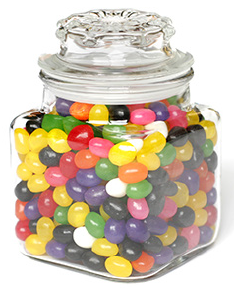This problem solving activity has a number (multiplication and division) focus.

Sonny got half as many lollies as Sam, and Sylvia got a third as many lollies as Sam got.
They got the same number of lollies each day up to (and including) Friday.
- If Sonny got 9 lollies on Wednesday, how many lollies did Sylvia get on Thursday?
- Is the number of lollies that Sylvia got over Monday, Tuesday, Wednesday and Thursday, less than the number Sonny got for the days Thursday and Friday?
- How many days does it take for the number of lollies Sonny got, to be greater than the number Sam got on Friday?
- Solve problems that involve halves and thirds.
- Use the terms 'greater than' and 'less than'.
In this problem students apply a range of strategies to solve fraction problems that involve one half and one third.
This is one of six problems: Lollies! and More Lollies, Number, Level 1; Sharing Lollies and Sharing More Lollies, Number, Level 2; Lollies, Lollies, Lollies, Number, Level 3; and Still More Lollies, Algebra, Level 4. These become increasingly algebraic at each level.
- Jellybean counters
- Copymaster of the problem (Māori)
- Copymaster of the problem (English)
The Problem
On Monday, Sam, Sonny and Sylvia share some lollies they'd been given. Sonny got half as many lollies as Sam, and Sylvia got a third as many lollies as Sam got. They got the same number of lollies each day up to (and including) Friday.
- If Sonny got 9 lollies on Wednesday, how many lollies did Sylvia get on Thursday?
- Is the number of lollies that Sylvia got over Monday, Tuesday, Wednesday and Thursday, less than the number Sonny got for the days Thursday and Friday?
- How many days does it take for the number of lollies Sonny got, to be greater than the number Sam got on Friday?
Teaching Sequence
- Pose the first part of the problem to the class.
- Ask some warm-up questions to get the students thinking about halves and thirds in the context of this problem.
If Sam has 12 lollies how many does Sylvia have? Explain how you know.
What about Sonny? - Discuss approaches they could use to solve the first part, and share solutions.
- As students work on rest of the problem in pairs, ask questions that focus on their choice of problem solving strategy and their understanding of fractions.
Can you tell me what you are doing?
Why did you decide to solve the problem that way?
What is a third? What is a half?
How do you know when you have third?
Which student would you like to be? Why?
Who has less lollies? How can you write this? (e.g. using < >).
Who has more lollies? How can you write this? (e.g. using < >).
Whose total number of lollies is greater than their friend's? - Share solutions to the problem. Discuss the different approaches used by the students. Highlight the use of greater than and less than in the discussion of the problem.
Solution
Sonny gets half as many lollies as Sam. So Sam gets twice as many lollies as Sonny. Sonny got 9 lollies, so Sam got 18.
Sylvia gets one third of Sam’s number (18). This is 6.
On any four days Sylvia will get 6 + 6 + 6 + 6 = 24. On any two days, Sonny will get 9 + 9 = 18. Since 24 > 18, then Sylvia gets more than Sonny.
Sam got 18 lollies on Friday. Sonny gets 9 lollies a day. On two days Sonny gets 9 + 9 = 18 which equals the number of lollies that Sam got on Friday. Over three days, Sonny gets 27 lollies. Since 27 > 18, then it takes Sonny 3 days to get more lollies than Sam.